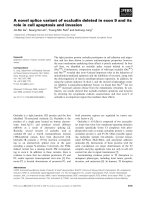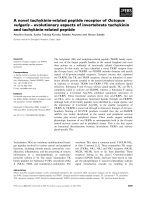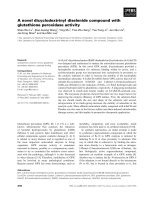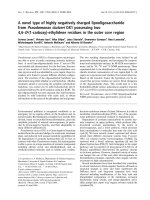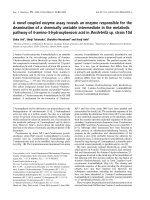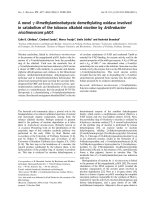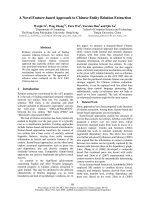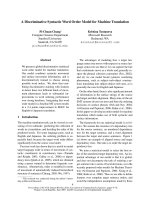Báo cáo khoa học: "A Novel Burst-based Text Representation Model for Scalable Event Detection" pptx
Bạn đang xem bản rút gọn của tài liệu. Xem và tải ngay bản đầy đủ của tài liệu tại đây (861.79 KB, 5 trang )
Proceedings of the 50th Annual Meeting of the Association for Computational Linguistics, pages 43–47,
Jeju, Republic of Korea, 8-14 July 2012.
c
2012 Association for Computational Linguistics
A Novel Burst-based Text Representation Model
for Scalable Event Detection
Wayne Xin Zhao
†
, Rishan Chen
†
, Kai Fan
†
, Hongfei Yan
†∗
and Xiaoming Li
†‡
†
School of Electronics Engineering and Computer Science, Peking University, China
‡
State Key Laboratory of Software, Beihang University, China
{batmanfly,tsunamicrs,fankaicn,yhf1029}@gmail.com,
Abstract
Mining retrospective events from text streams
has been an important research topic. Classic
text representation model (i.e., vector space
model) cannot model temporal aspects of doc-
uments. To address it, we proposed a novel
burst-based text representation model, de-
noted as BurstVSM. BurstVSM corresponds
dimensions to bursty features instead of terms,
which can capture semantic and temporal in-
formation. Meanwhile, it significantly reduces
the number of non-zero entries in the repre-
sentation. We test it via scalable event de-
tection, and experiments in a 10-year news
archive show that our methods are both effec-
tive and efficient.
1 Introduction
Mining retrospective events (Yang et al., 1998; Fung
et al., 2007; Allan et al., 2000) has been quite an im-
portant research topic in text mining. One standard
way for that is to cluster news articles as events by
following a two-step approach (Yang et al., 1998):
1) represent document as vectors and calculate simi-
larities between documents; 2) run the clustering al-
gorithm to obtain document clusters as events.
1
Un-
derlying text representation often plays a critical role
in this approach, especially for long text streams. In
this paper, our focus is to study how to represent
temporal documents effectively for event detection.
Classical text representation methods, i.e., Vector
Space Model (VSM), have a few shortcomings when
dealing with temporal documents. The major one is
that it maps one dimension to one term, which com-
pletely ignores temporal information, and therefore
VSM can never capture the evolving trends in text
streams. See the example in Figure 1, D
1
and D
2
∗
Corresponding author.
1
Post-processing may be also needed on the preliminary
document clusters to refine the results.
!"
!#
$%&'
()*+*
, /01#223
, /01#224
Figure 1: A motivating example. D
1
and D
2
are news
articles about U.S. presidential election respectively in
years 2004 and 2008.
may have a high similarity based on VSM due to the
presence of some general terms (e.g., “election”) re-
lated to U.S. presidential election, although general
terms correspond to events in different periods (i.e.,
November 2004 and November 2008). Temporal
information has to be taken into consideration for
event detection. Another important issue is scala-
bility, with the increasing of the number in the text
stream, the size of the vocabulary, i.e., the number
of dimensions in VSM, can be very large, which re-
quires a considerable amount of space for storage
and time for downstream processing.
To address these difficulties, in this paper, we pro-
pose a burst based text representation method for
scalable event detection. The major novelty is to nat-
urally incorporate temporal information into dimen-
sions themselves instead of using external time de-
caying functions (Yang et al., 1998). We instantiate
this idea by using bursty features as basic representa-
tion units of documents. In this paper, bursty feature
refers to a sudden surge of the frequency of a single
term in a text stream, and it is represented as the term
itself together with the time interval during which
the burst takes place. For example, (Olympic,
Aug-08-2008, Aug-24-2008)
2
can be regarded
as a bursty feature. We also call the term in a bursty
2
Beijing 2008 Olympic Games
43
feature its bursty term. In our model, each dimen-
sion corresponds to a bursty feature, which contains
both temporal and semantic information. Bursty fea-
tures capture and reflect the evolving topic trends,
which can be learnt by searching surge patterns in
stream data (Kleinberg, 2003). Built on bursty fea-
tures, our representation model can well adapt to text
streams with complex trends, and therefore provides
a more reasonable temporal document representa-
tion. We further propose a split-cluster-merge algo-
rithm to generate clusters as events. This algorithm
can run a mutli-thread mode to speed up processing.
Our contribution can be summarized as two as-
pects: 1) we propose a novel burst-based text rep-
resentation model, to our best knowledge, it is the
first work which explicitly incorporates temporal in-
formation into dimensions themselves; 2) we test
this representation model via scalable event detec-
tion task on a very large news corpus, and extensive
experiments show the proposed methods are both ef-
fective and efficient.
2 Burst-based Text Representation
In this section, we describe the proposed burst-based
text representation model, denoted as BurstVSM. In
BurstVSM, each document is represented as one
vector as in VSM, while the major novelty is that one
dimension is mapped to one bursty feature instead
of one term. In this paper, we define a bursty fea-
ture f as a triplet (w
f
,t
f
s
,t
f
e
), where w is the bursty
term and t
s
and t
e
are the start and end timestamps
of the bursty interval (period). Before introducting
BurstVSM, we first discuss how to identify bursty
features from text streams.
2.1 Burst Detection Algorithm
We follow the batch mode two-state automaton
method from (Kleinberg, 2003) for bursty feature
detection.
3
In this model, a stream of documents
containing a term w are assumed to be generated
from a two-state automaton with a low frequency
state q
0
and a high frequency state q
1
. Each state
has its own emission rate (p
0
and p
1
respectively),
and there is a probability for changing state. If an
interval of high states appears in the optimal state
sequence of some term, this term together with this
interval is detected as a bursty feature. To obtain
all bursty features in text streams, we can perform
burst detection on each term in the vocabulary. In-
stead of using a fixed p
0
and p
1
in (Kleinberg, 2003),
by following the moving average method (Vlachos
3
The news articles in one day is treated as a batch.
et al., 2004) ,we parameterize p
0
and p
1
with the
time index for each batch, formally, we have p
0
(t)
and p
1
(t) for the tth batch. Given a term w, we
use a sliding window of length L to estimate p
0
(t)
and p
1
(t) for the tth batch as follows: p
0
(t)=
�
j∈W
t
N
j,w
�
j∈W
t
N
j
and p
1
(t)=p
0
(t) × s, where N
j,w
and
N
j
are w ’s document frequency and the total num-
ber of documents in jth batch respectively. s is a
scaling factor lager than 1.0, indicating state q
1
has
a faster rate, and it is empirically set as 1.5. W
t
is a
time interval [max(t −L/2, 0), min(t +L/2,N)], and
the length of moving window L is set as 180 days.
All the other parts remain the same as in (Kleinberg,
2003). Our detection method is denoted as TVBurst.
2.2 Burst based text representation models
We apply TVBurst to all the terms in our vocabu-
lary to identify a set of bursty features, denoted as
B. Given B, a document d
i
(t) with timestamp t is
represented as a vector of weights in bursty feature
dimensions:
d
i
(t)=(d
i,1
(t),d
i,2
(t), ,d
i,|B|
(t)).
We define the jth weight of d
i
as follows
d
i,j
=
�
tf-idf
i,w
B
j
, if t ∈ [t
B
j
s
,t
B
j
e
] ,
0, otherwise.
When the timestamp of d
i
is in the bursty inter-
val of B
j
and contains bursty term w
B
j
, we set up
the weight using common used tf-idf method. In
BurstVSM, each dimension is mapped to one bursty
feature, and it considers both semantic and temporal
information. One dimension is active only when the
document falls in the corresponding bursty interval.
Usually, a document vector in BurstVSM has only
a few non-zero entries, which makes computation of
document similarities more efficient in large datasets
compared with traditional VSM.
The most related work to ours is the boostVSM
introduced by (He et al., 2007b), it proposes to
weight different term dimensions with correspond-
ing bursty scores. However, it is still based on term
dimensions and fails to deal with terms with mul-
tiple bursts. Suppose that we are dealing with a
text collection related with U.S. presidential elec-
tions, Fig. 2 show sample dimensions for these three
methods. In BurstVSM, one term with multiple
bursts will be naturally mapped to different dimen-
sions. For example, two bursty features ( presiden-
tial, Nov., 2004) and ( presidential, Nov., 2008 ) cor-
respond to different dimensions in BurstVSM, while
44
Figure 2: One example for comparisons of different rep-
resentation methods. Terms in red box correspond to
multiple bursty periods.
Table 1: Summary of different representation models.
Here dimension reduction refers to the reduction of non-
zero entries in representation vector.
semantic temporal dimension trend
information information reduction modeling
VSM � × × bad
boostVSM � partially × moderate
BurstVSM � � � good
VSM and boostVSM cannot capture such temporal
differences. Some methods try to design time de-
caying functions (Yang et al., 1998), which decay
the similarity with the increasing of time gap be-
tween two documents. However, it requires efforts
for function selection and parameters tuning. We
summarize these discussions in Table 1.
3 split-cluster-merge algorithm for event
detection
In this section, we discuss how to cluster documents
as events. Since each document can be represented
as a burst-based vector, we use cosine function to
compute document similarities. Due to the large size
of our news corpus, it is infeasible to cluster all the
documents straightforward. We develop a heuristic
clustering algorithm for event detection, denoted as
split-cluster-merge, which includes three main steps,
namely split, cluster and merge. The idea is that we
first split the dataset into small parts, then cluster
the documents of each part independently and finally
merge similar clusters from two consecutive parts.
In our dataset, we find that most events last no more
than one month, so we split the dataset into parts by
months. After splitting, clustering can run in paral-
lel for different parts (we use CLUTO
4
as the cluster-
ing tool), which significantly reduces total time cost.
For merge, we merge clusters in consecutive months
with an empirical threshold of 0.5. The final clusters
4
www.cs.umn.edu/
˜
karypis/cluto
are returned as identified events.
4 Evaluation
4.1 Experiment Setup
We used a subset of 68 millon deduplicated
timestamped web pages generated from this
archive (Huang et al., 2008). Since our major focus
is to detect events from news articles, we only keep
the web pages with keyword “news” in URL field.
The final collection contains 11, 218, 581 articles
with total 1, 730, 984, 304 tokens ranging from 2000
to 2009. We run all the experiments on a 64-bit linux
server with four Quad-Core AMD Opteron(tm) Pro-
cessors and 64GB of RAM. For split-cluster-merge
algorithm, we implement the cluster step in a multi-
thread mode, so that different parts can be processed
in parallel.
4.2 Construction of test collection
We manually construct the test collection for event
detection. To examine the effectiveness of event de-
tection methods in different grains, we consider two
type of events in terms of the number of relevant
documents, namely significant events and moder-
ate events. A significant event is required to have
at least 300 relevant docs, and a moderate event is
required to have 10 ∼ 100 relevant docs. 14 grad-
uate students are invited to generate the test collec-
tion, starting with a list of 100 candidate seed events
by referring to Xinhua News.
5
For one target event,
the judges first construct queries with temporal con-
straints to retrieve candidate documents and then
judge wether they are relevant or not. Each doc-
ument is assigned to three students, and we adopt
the majority-win strategy for the final judgment. Fi-
nally, by removing all candidate seed events which
neither belong to significant events nor moderate
events, we derive a test collection consisting of 24
significant events and 40 moderate events.
6
4.3 Evaluation metrics and baselines
Similar to the evaluation in information retrieval ,
given a target event, we evaluate the quality of the
returned “relevant” documents by systems. We use
average precision, average recall and mean average
precision(MAP) as evaluation metrics. A difference
is that we do not have queries, and the output of a
system is a set of document clusters. So for a sys-
tem, given an event in golden standard, we first se-
lect the cluster (the system generates) which has the
5
/>6
For access to the code and test collection, contact Xin Zhao
via batmanfl
45
Table 2: Results of event detection. Our proposed method is better than all the other baselines at confidence level 0.9.
Signifcant Events Moderate Events
P R F MAP P R F MAP
timemines-χ
2
(nouns) 0.52 0.2 0.29 0.11 0.22 0.27 0.24 0.09
timemines-χ
2
(NE) 0.61 0.18 0.28 0.08 0.27 0.25 0.26 0.13
TVBurst+boostVSM 0.67 0.44 0.53 0.31 0.22 0.39 0.28 0.13
swan+BurstVSM 0.74 0.56 0.64 0.48 0.39 0.54 0.45 0.38
kleiberg+BurstVSM 0.68 0.63 0.65 0.52 0.35 0.53 0.42 0.36
TVBurst+BurstVSM 0.78 0.69 0.73 0.63 0.4 0.61 0.48 0.39
Table 3: Comparisons of average intra-class and inter-
class similarity.
Significant Events Moderate Events
Methods Intra Inter Intra Inter
TVBurst+boostVSM 0.234 0.132 0.295 0.007
TVBurst+BurstVSM 0.328 0.014 0.480 0.004
most relevant documents, then sort the documents
in the descending order of similarities with the clus-
ter centroid and finally compute P, R ,F and MAP in
this cluster. We perform Wilcoxon signed-rank test
for significance testing.
We used the event detection method in (Swan
and Allan, 2000) as baseline, denoted as timemines-
χ
2
. As (Swan and Allan, 2000) suggested, we
tried two versions: 1) using all nouns and 2) us-
ing all named entities. Recall that BurstVSM re-
lies on bursty features as dimensions, we tested dif-
ferent burst detection algorithms in our proposed
BurstVSM model, including swan (Swan and Al-
lan, 2000), kleinberg (Kleinberg, 2003) and our pro-
posed TVBurst algorithm.
4.4 Experiment results
Preliminary results. In Table 2, we can see that 1)
BurstVSM with any of these three burst detection al-
gorithms is significantly better than timemines-χ
2
,
suggesting our event detection method is very ef-
fective; 2) TVBurst with BurstVSM gives the best
performance, which suggests using moving average
base probability will improve the performance of
burst detection. We use TVBurst as the default burst
detection algorithm in later experiments.
Then we compare the performance of differ-
ent text representation models for event detection,
namely BurstVSM and boostVSM (He et al., 2007b;
He et al., 2007a).
7
For different representation mod-
els, we use split-cluster-merge as clustering algo-
rithm. Table 2 shows that BurstVSM is much ef-
fecitve than boostVSM for event detection. In fact,
we empirically find boostVSM is appropriate for
7
We use the same parameter settings in the original paper.
Table 4: Comparisons of observed runtime and storage.
boostVSM BurstVSM
Aver. # of non-zero entries per doc 149 14
File size for storing vectors (gigabytes) 3.74 0.571
Total # of merge 10,265,335 9,801,962
Aver. cluster cost per month (sec.) 355 55
Total merge cost (sec.) 2,441 875
Total time cost (sec.) 192,051 4,851
clustering documents in a coarse grain (e.g., in topic
level) but not for event detection.
Intra-class and inter-class similarities. In our
methods, event detection is treated as document
clustering. It is very important to study how similari-
ties affect the performance of clustering. To see why
our proposed representation methods are better than
boostVSM, we present the average intra-class simi-
larity and inter-class similarity for different events in
Table 3.
8
We can see BurstVSM results in a larger
intra-class similarity and a smaller inter-class simi-
larity than boostVSM.
Analysis of the space/time complexity. We fur-
ther analyze the space/time complexity of different
representation models. In Table 4. We can see that
BurstVSM has much smaller space/time cost com-
pared with boostVSM, and meanwhile it has a better
performance for event detection (See Table 2). In
burst-based representation, one document has fewer
non-zero entries.
Acknowledgement. The core idea of this work
is initialized and developped by Kai Fan. This
work is partially supported by HGJ 2010 Grant
2011ZX01042-001-001, NSFC Grant 61073082 and
60933004. Xin Zhao is supported by Google PhD
Fellowship (China). We thank the insightful com-
ments from Junjie Yao, Jing Liu and the anony-
mous reviewers. We have developped an online Chi-
nese large-scale event search engine based on this
work, visit for
more details.
8
For each event in our golden standard, we have two clus-
ters: relevant documents and non-relevant documents(within
the event period).
46
References
James Allan, Victor Lavrenko, and Hubert Jin. 2000.
First story detection in TDT is hard. In Proceedings
of the ninth international conference on Information
and knowledge management.
Gabriel Pui Cheong Fung, Jeffrey Xu Yu, Huan Liu, and
Philip S. Yu. 2007. Time-dependent event hierarchy
construction. In SIGKDD.
Q. He, K. Chang, and E. P. Lim. 2007a. Using burstiness
to improve clustering of topics in news streams. In
ICDM.
Qi He, Kuiyu Chang, Ee-Peng Lim, and Jun Zhang.
2007b. Bursty feature representation for clustering
text streams. In SDM.
L. Huang, L. Wang, and X. Li. 2008. Achieving both
high precision and high recall in near-duplicate detec-
tion. In CIKM.
J. Kleinberg. 2003. Bursty and hierarchical structure in
streams. Data Mining and Knowledge Discovery.
Russell Swan and James Allan. 2000. Automatic gener-
ation of overview timelines. In SIGIR.
Michail Vlachos, Christopher Meek, Zografoula Vagena,
and Dimitrios Gunopulos. 2004. Identifying similari-
ties, periodicities and bursts for online search queries.
In SIGMOD.
Yiming Yang, Tom Pierce, and Jaime Carbonell. 1998.
A study of retrospective and on-line event detection.
In SIGIR.
47

